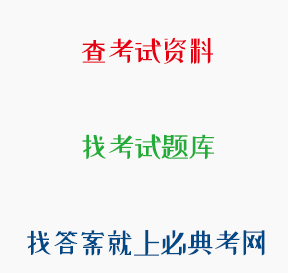正确答案:
题目:新课程背景下教师角色应发生哪些转变?(4分)
查看原题 查看所有试题
学习资料的答案和解析:
[单选题]针对已有教学方法不足,李老师提出并在实践中不断完善情景教学法,取得良好成效,这充分体现了李老师()。
勇于探索创新
解析:《中小学教师职业道德规范》(2008修订)"终身学习"规定,教师要树立终身学习理念,拓宽知识视野,更新知识结构,不断提高专业素养和教育教学水平。李老师在已有的教学方法的基础上,不断完善情境教学法,这是在教学实践中探索和创新,故选则A。
[单选题]一个国家教育经费投入的多少最终取决于( )。
生产力水平
解析:生产力对教育有制约作用,主要体现在:生产力水平决定了教育发展的水平,生产力水平决定教育的规模和速度,生产力水平制约教育体制、结构的变化,生产力水平制约着教育的内容和手段。
[单选题]孔子通过"视其所以""观其所由""察其所安…'退而省其私"等方法,细致地了解和研究每一个学生。这种针对每个学生特点的教学方式符合教学的( )。
因材施教原则
解析:因材施教原则是指教师在教学中,要从课程计划、学科课程标准的统一要求出发,面向全体学生,同时又要根据学生的个别差异,有的放矢地进行教学,使每个学生都能扬长避短,获得最佳发展。从题干中"这种针对每个学生特点的教学方式"可以得出符合教学的因材施教原则。
[单选题]"七步成诗"的故事体现的是思维过程的( )。
敏捷性
解析:"七步成诗"体现了短时间内的思维过程,体现了思维的敏捷性。
[单选题]学习动机支配着学习者的学习行为。小刘为了得到老师或父母的奖励而努力学习,则他的学习动机是( )。
外部动机
解析:根据动机产生的诱因来源,可以把学习动机分为内部学习动机和外部学习动机。内部动机是人们对学习本身的兴趣所引起的动机。外部动机是由外部诱因所引起的动机。
[单选题]7-11岁儿童认知大体处于( )阶段。
具体运算
解析:具体运算阶段为7-11岁,认知特点有这个阶段的标志是守恒观念的形成(守恒性);思维运算必须有具体的事物支持,可以进行简单抽象思维;理解原则和规则,但只能刻板遵守规则,不敢改变;思维具有可逆性(儿童思维发展的最重要特征)。故选择C。A选项,感知运动阶段为0-2岁,仅靠感觉和动作适应外部环境,应付外界事物。认知特点有通过探索感知与运动之间的关系来获得动作经验:低级的行为图式;获得了客体的永恒性(9~12个月)。B选项,前运算阶段为2-7岁,认知特点有"万物有灵论";一切以自我为中心;思维具有不可逆性、刻板性;没有守恒概念;作出判断时只能运用一个标准或维度。D选项,形式运算阶段为11-16岁认知特点为能够根据逻辑推理、归纳或演绎方式来解决问题:能够理解符号意义、隐喻和直喻,能作一定的概括;思维具有可逆性、补偿性和灵活性。
[单选题]请阅读 Passage 2,完成1~5小题。
Passage 2
IF YOU want something done,the saying goes,give it to a busy person.It is an odd way to guarantee hitting deadlines.But a paper recently published in the Journal of Consumer Research suggests it may,in fact,be true-as long as the busy person conceptualises the deadline in the right way.
Yanping Tu of the University of Chicago and Dilip Soman of the University of Toronto
examined how individuals go about both thinking about and completing tasks.Previous studies have shown that such activity progresses through four distinct phases: pre-decision,post-decision (but pre-action),action and review.It is thought that what motivates the shift from the decision-making stages to the doing-something stage is a change in mindset.
Human beings are a deliberative sort,weighing the pros and cons of future actions and remaining open to other ideas and influences.However,once a decision is taken,the mind becomes more "implemental" and focuses on the task at hand."The mindset towards 'where can I get a sandwich'," explains Ms Tu,"is more implemental than the mindset towards 'should I get a sandwich or not?'"
Ms Tu and Dr Soman advise in their paper that "the key step in getting things done is to get started." But what drives that? They believe the key that unlocks the implemental mode lies in how people categorise time.They suggest that tasks are more likely to be viewed with an implemental mindset if an imposed deadline is cognitively linked to "now" -a so-called like-the-present scenario.That might be a future date within the same month or calendar year,or pegged to an event with a familiar spot in the mind's timeline (being given a task at Christmas,say,with a deadline of Easter).Conversely,they suggest,a deadline placed outside such mental constructs (being "unlike-the-present" ) exists merely as a circle on a calendar,and as such is more likely to be considered deliberatively and then ignored until the last minute.
To flesh out this ideA.the pair carried out five sets of tests,with volunteers ranging from farmers in India to undergraduate students in Toronto.In one test,the farmers were offered a financial incentive to open a bank account and make a deposit within six months.The researchers predicted those approached in June would consider a deadline before December 31st as like-the-present.Those approached in July,by contrast,received a deadline into the next year,and were expected to think of their deadline as unlike-the-present.The distinction worked.Those with a deadline in the same year were nearly four times more likely to open the account immediately as those for whom the deadline lay in the following year.Arbitrary though calendars may be in parsing up the continuous fiow of time,humans parse their concept of time in line with them.
The effect can manifest itselfin even subtler ways.In another set of experiments,undergraduate students were given a calendar on a Wednesday and were asked to suggest an appropriate day to carry out certain tasks before the following Sunday.The trick was that some were given a calendar with all of the weekdays coloured purple,with weekends in beige (making a visual distinction between a Wednesday and the following Sunday).Others were given a calendar in which every other week,Monday to Sunday,was a solid colour (meaning that a Wednesday and the following Sunday were thus in the same week,and in the same colour).Even this minor visual cue affected how like-or unlike-the-present the respondents tended to view task priorities.
These and other bits of framing and trickery in the research support the same thesis: that making people link a future event to today triggers an implemental response,regardless of how far in the future the deadline actually lies.If the journey of l,000 miles starts with a single step,the authors might suggest that you take that step before this time next week.
Which best describes the author's tone?
Objective.
解析:态度题。humanistic“人文主义的”,objective“客观的”,speculative“推理的,思考的”,recriminatory“互相指责的,反控诉的”。全文作者以客观的态度阐述观点,故本题选B。

 川公网安备 51012202001360号
川公网安备 51012202001360号